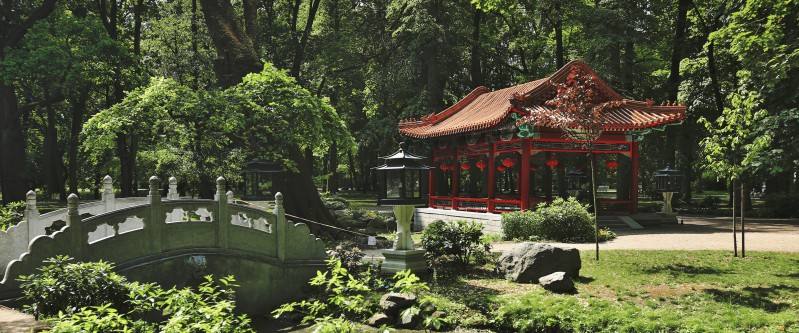 Garden - Łazienki Warszawskie
Garden - Łazienki Warszawskie
Łazienki Warszawskie is wonderful, historic palace and garden location, today lying in the middle of the city, once beyond its borders. This is one of the pavilions built in the second half of the 7th century by the Grand Marshal of the Crown, Stanisław Herakliusz Lubomirski, with a bathroom in it, he gave the name, which passed to the building, and then the whole garden. This original Bathroom of Lubomirski is located within the walls of the present Palace on the Isle. In the foreground of the Castle there is a five-kilometer entrance alley, running all the way from Wola. Based on this axis, a system of straightly delimited avenues developed, converging in round squares. Alleys and places, spread out among cultivated fields, planted with lime trees, became the nucleus of a new district, which is gradually built up, today it is a large part of the city. On the northern side of the island there is a water terrace, and decorative stairs lead into the water on both sides of the Łazienki Park. On both sides of the building there are galleries covered with green and gilded roofs and bridges, from which the west leads to a straight avenue, the so-called. The Royal Promenade, running in the middle of two water channels and connecting the Bathhouse with the White House. On both sides of this avenue there are openwork wooden structures covered with Indian acacia., which is today's upper southern pond. By erecting a new façade of the Bathhouse, this channel was transformed into a great lower southern pond, with a picturesque shoreline. At the same time, the former northern pond with the canal was changed in a similar way, up to the road of Agrykola. In this way, a new one was created, irregular assumption, reflecting the fashion for a landscaped garden. Łaźnia became the center of this establishment, royal villa, now perfectly visible from north and south, above the water surface. The compositional axis of the assumption remained so clearly emphasized, according to the fashion imperative, animated by a clump with an old tree stand. The Palace itself achieved an impressive appearance with pavilions connected on the mainland by stone bridges decorated with column galleries. At the western end of the garden, the building of the Great Orangery was built, today called the Old Orangery. In front of the southern façade of the Great Orangery, a geometric garden with sculptures has been arranged. Okrglak is also one of the buildings in Łazienki, being a reservoir, from which water flows through pipes hidden in the ground - to the Palace on the Isle and the fountains on the island's terrace. The areas on the escarpment were designated as the Botanical Garden in harmony with the natural landscape. The Monument to Fryderyk Chopin stands on the slope plateau. The area of Łazienki is full of many decorative objects, residential, for relaxation. In the immediate vicinity of the Palace on the Isle, in the eastern part of the garden, it stands of considerable size, but with a modest external appearance, two-story building. so-called. Great Outbuilding, also called the Cadet School. Besides her, in front of the entrance from Agrykoli Street there is the Myślewicki Palace. On the shore of the northern pond there is the Old Guardhouse, once occupied by the royal guard. From the Kordegarda, your gaze goes towards the bridge closing the pond from the north. Over three arcades, stone bridge, there is the equestrian Monument of King Jan III Sobieski. The Amphitheater is situated on the shore of the southern pond. After seeing the Amphitheater, you can go to the southern pond, to admire the beautiful view of the Łazienki Palace from its ends. To the west of the Palace there is an object called the New Guardhouse. Further, South, over the pond at the foot of the Belvedere Palace, is the Temple of Diana. The building, built of wood, contains a room with a painting decoration in the form of floral ornaments and still lifes.. The Egyptian Temple closes the southern end of the garden, which was originally part of the playhouse. Further on, on the Wilanowska road, we come across the New Orangery building. There is an exotic garden in this building, open to the public. After the renovation and adaptation of all historic buildings, the bathrooms should become a living museum of Polish culture.
